|
Chic vs. Sleek
Art Deco vs. Art Moderne
by
Bob Brooke
Art Deco—those two words bring to mind
sleek forms and chic design. Many believe the style began in America.
But actually its origins go much further back to France on the other
side of the Atlantic. Arte Moderne, on the other hand, was decidedly an
American invention. Although taking its design concepts from Art Deco,
it was a completely different style. Unfortunately, this is the style
most Americans confuse with Art Deco.
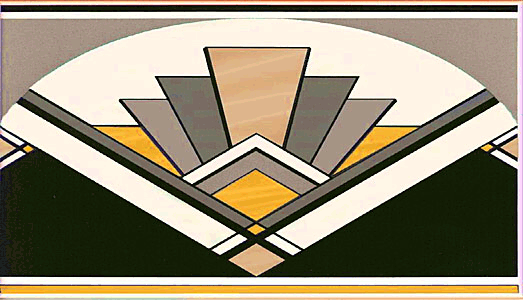
Art Deco
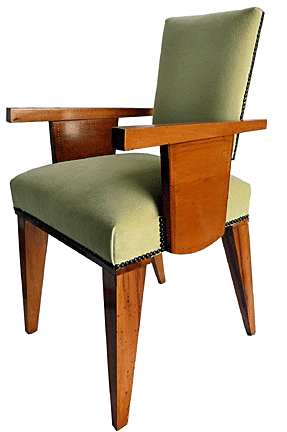 The
Art Deco style made its debut at the 1925 World's Fair in Paris—the
Exposition Internationale des Arts Décoratifs et Industriels Modernes or
the International Exhibition of Modern and Industrial Decorative
Arts—but the name Art Deco wasn’t used until 1966. A group of French
architects and interior designers, who banded together to form the
Societe des Artistes Decorateurs, developed the style to incorporate
elements of style from diverse artworks and current fashion trends.
Influence from Cubism and Surrealism, Egyptian and African folk art are
evident in the lines and embellishments, and Asian influences contribute
symbolism, grace and detail. The
Art Deco style made its debut at the 1925 World's Fair in Paris—the
Exposition Internationale des Arts Décoratifs et Industriels Modernes or
the International Exhibition of Modern and Industrial Decorative
Arts—but the name Art Deco wasn’t used until 1966. A group of French
architects and interior designers, who banded together to form the
Societe des Artistes Decorateurs, developed the style to incorporate
elements of style from diverse artworks and current fashion trends.
Influence from Cubism and Surrealism, Egyptian and African folk art are
evident in the lines and embellishments, and Asian influences contribute
symbolism, grace and detail.
The Exposition Internationale des Arts Décoratifs et Industriels
Modernes in Paris was a vast state-sponsored fair that dazzled more than
16 million visitors during its seven-month run. The works
exhibited—everything from architecture and interior design to jewelry
and perfumes—were principally intended to promote and proclaim French
supremacy in the production of luxury goods. The primary requirement for
inclusion of the more than 20 countries invited to participate was that
all works had to be thoroughly modern—no copying of historical styles of
the past would be permitted. However, many of the objects exhibited were
rooted in the traditions of the past.
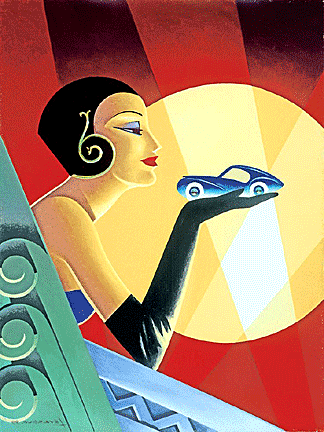 Art
Deco was already an internationally mature style by 1925—one that had
flourished in the years following World War I and peaked at the time of
the fair. The enormous commercial success of Art Deco ensured that
designers and manufacturers throughout Europe continued to promote this
style until well into the 1930s. . Art
Deco was already an internationally mature style by 1925—one that had
flourished in the years following World War I and peaked at the time of
the fair. The enormous commercial success of Art Deco ensured that
designers and manufacturers throughout Europe continued to promote this
style until well into the 1930s. .
Art Deco reflected the general optimism and carefree mood that swept
Europe and the United States following World War I. Hope and prosperity
are represented in sunburst designs, chevrons and references to the good
life in the elegant figures depicted in casual, sensual poses, often
dancing or sipping cocktails. The modern influences heralded a bright
and shining future outlook that found its way to architecture, jewelry,
automobile design and even extended to ordinary things such as
refrigerators and trash cans.
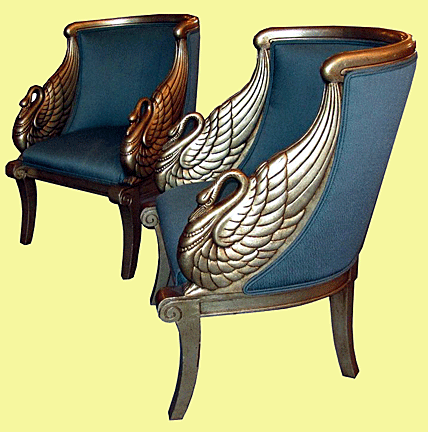 Art
Deco is a decorative style that is essentially an extension of the
French Art Nouveau and English Aesthetic styles, but also includes
elements of Arts and Crafts form. Art
Deco is a decorative style that is essentially an extension of the
French Art Nouveau and English Aesthetic styles, but also includes
elements of Arts and Crafts form.
The style emphasizes surface embellishment, drawing heavily on the
colors and styles of some of the early modern art movements, from
Impressionism through Cubism. Like many of the modern art styles, it was
inspired by Chinese and Japanese art.
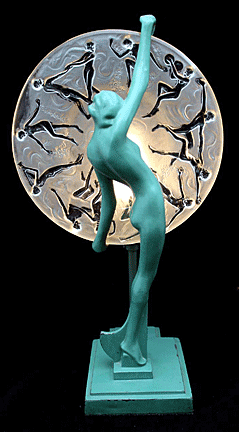 Sometimes
ornamentation was straightforwardly applied to the surface of an object,
like a decorative skin; other times, potentially utilitarian
designs—bowls, plates, vases, even furniture—were in and of themselves
purely ornamental, not intended for practical use but rather conceived
for their decorative value alone, exploiting the singular beauty of form
or material. Painting and sculpture—again, conceived mainly as
decoration rather than as serious works of fine art—were an important
aspect of Art Deco, as well. Among the most popular and recurring motifs
are the human figure, animals, flowers, and plants; abstract geometric
decoration was also prevalent. . Sometimes
ornamentation was straightforwardly applied to the surface of an object,
like a decorative skin; other times, potentially utilitarian
designs—bowls, plates, vases, even furniture—were in and of themselves
purely ornamental, not intended for practical use but rather conceived
for their decorative value alone, exploiting the singular beauty of form
or material. Painting and sculpture—again, conceived mainly as
decoration rather than as serious works of fine art—were an important
aspect of Art Deco, as well. Among the most popular and recurring motifs
are the human figure, animals, flowers, and plants; abstract geometric
decoration was also prevalent. .
Exoticism also played a role in Art Deco. During the 1920s and 1930s,
the French government encouraged designers to take advantage of
resources—like raw materials and a skilled workforce—that could be
imported from the nation's colonies in Asia and Africa. The resulting
growth of interest in the arts of colonial countries in Asia and Africa
led French designers to explore new materials (sharkskin, ivory, and
exotic woods), techniques (lacquering, ceramic glazes), and forms that
evoke faraway places and cultures.
Though it spread to other countries, Art Deco was a distinctively French
response to the postwar demand for luxurious objects and fine
craftsmanship. French designers utilized lavish materials and such rich,
traditional decorative techniques as inlay and veneer on streamlined
geometric forms.
Art Moderne
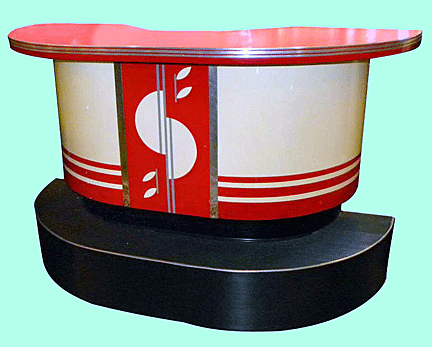 Sometimes
classified as a later phase of Art Deco, Art Moderne is often confused
with its predecessor. Art Moderne is a horizontal design, emphasizing
movement and sleekness; Art Deco emphasizes verticality and stylized,
geometric ornamentation. Sometimes
classified as a later phase of Art Deco, Art Moderne is often confused
with its predecessor. Art Moderne is a horizontal design, emphasizing
movement and sleekness; Art Deco emphasizes verticality and stylized,
geometric ornamentation.
If Art Deco had its roots in France, Art Moderne is decidedly American,
dating from the early 1930s and lasting until the 1940s. It was bigger,
bolder, and brassier—just like America at the time. Think of Art Moderne
as Art Deco on steroids. Art Deco placed an emphasis on shape and
absence of superfluity, but Moderne was streamlined.
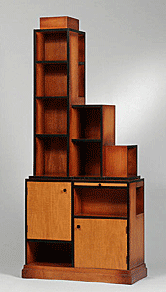 Moderne
designers subscribed to an ideal of the machine-made. Moderne
designers subscribed to an ideal of the machine-made.
Like the Austrian-born Paul Frankl, many Moderne designers, including
K.E.M Weber and Josef Urban, were immigrants from Europe. Other major
Moderne names include Paul Fuller, Donald Deskey, Norman Bel Geddes, and
Russel Wright.
Art Deco and Art Moderne overlap, both stylistically and
chronologically, Frankl's first Skyscraper furniture, for example, dates
from the late 1920s. Of the two, Art Deco is the more familiar term.
But in the end, it's more a question of style than dates. Think of Art
Deco as chic, Moderne as sleek. Or Art Deco as organic, Moderne as
mechanic, the former reveling in restrained craftsmanship, the latter a
celebration of geometric shape, as precise as only a machine can make
it.
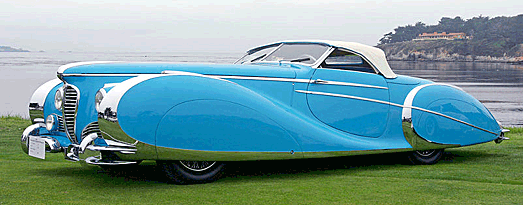
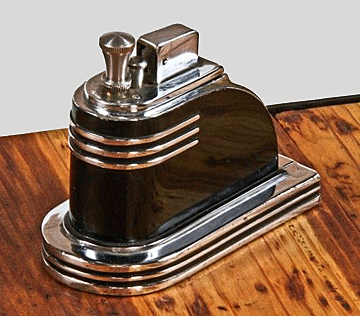 Streamline
Moderne, or Art Moderne, is a late type of Art Deco design that emerged
in the 1930s. While rich colors, bold geometry, and decadent detail work
characterized Art Deco, evoking glamour, luxury, and order with
symmetrical designs in exuberant shapes, Art Moderne is essentially a
machine aesthetic focused on mass production, functional efficiency, and
a more abstract aesthetic coming from the Bauhaus in Germany. Streamline
Moderne, or Art Moderne, is a late type of Art Deco design that emerged
in the 1930s. While rich colors, bold geometry, and decadent detail work
characterized Art Deco, evoking glamour, luxury, and order with
symmetrical designs in exuberant shapes, Art Moderne is essentially a
machine aesthetic focused on mass production, functional efficiency, and
a more abstract aesthetic coming from the Bauhaus in Germany.
<
Back to Antiques Archives
Next Article >
|
